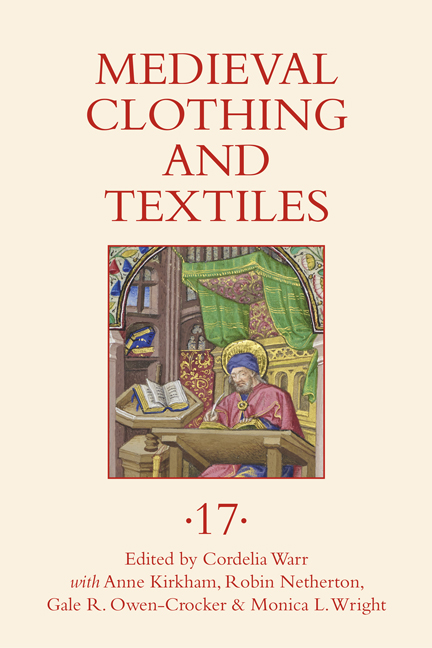Book contents
- Frontmatter
- Contents
- Illustrations
- Tables
- Contributors
- Acknowledgements
- Preface
- 1 Embroidered Beasts: Animals in the Bayeux Tapestry
- 2 The Sleeve from Bussy-Saint-Martin: A Rare Example of Medieval Quilted Armor
- 3 The Administration of Cloth and Clothing in the Great Wardrobe of Edward I
- 4 Hanging Together: Furnishing Textiles in a Fifteenth-Century Book of Hours
- 5 Gilt-leather Embroideries from Medieval Sweden and Finland
- 6 From Hennin to Hood: An Analysis of the Evolution of the English Hood Compared to the Evolution of the French Hood
- Recent Books of Interest
- Author Index, Volumes 1–16
4 - Hanging Together: Furnishing Textiles in a Fifteenth-Century Book of Hours
Published online by Cambridge University Press: 17 December 2023
- Frontmatter
- Contents
- Illustrations
- Tables
- Contributors
- Acknowledgements
- Preface
- 1 Embroidered Beasts: Animals in the Bayeux Tapestry
- 2 The Sleeve from Bussy-Saint-Martin: A Rare Example of Medieval Quilted Armor
- 3 The Administration of Cloth and Clothing in the Great Wardrobe of Edward I
- 4 Hanging Together: Furnishing Textiles in a Fifteenth-Century Book of Hours
- 5 Gilt-leather Embroideries from Medieval Sweden and Finland
- 6 From Hennin to Hood: An Analysis of the Evolution of the English Hood Compared to the Evolution of the French Hood
- Recent Books of Interest
- Author Index, Volumes 1–16
Summary
The prayer book Rylands Latin MS 164, produced in the mid-fifteenth century in Paris, is regarded by the John Rylands Library in Manchester, England, as its “finest” Book of Hours. Undoubtedly this accolade is indebted to both the quantity and the quality of its illumination (even though a few of the most significant pages of the book are missing). All pages have some border decoration and seventy-four of its 267 pages are designed with highly accomplished painted miniatures. Not the least of this accomplished painting are the sumptuous textile hangings and curtains, canopies, and cushions that feature in twenty-seven of the images, for example as part of the fitting out of the hall in which a lord feasts on the calendar page for January (fol. 1r) or as a screen stretched out across the landscape behind a group of worshippers in the miniature accompanying the Lord's Prayer (fol. 13r, fig. 4.1). Throughout this book, the furnishing textiles catch the eye with their bright colours, decorative gold patterns, and naturalistic rendering of drapes and folds. What a frequent viewer of the book—perhaps today's researcher, but, surely, its owners in the late Middle Ages—would also notice is the repetition of certain textiles in a number of the paintings. The most elaborate of these repeated textiles, included in twenty miniatures, is a purple cloth ornamented with gold plant forms and geometric patterns (figs. 4.1 to 4.6). Notably, it is seen on a number of the pages of special significance in a Book of Hours, including the openings of the gospel texts of Luke (fig. 4.3), Matthew, and Mark (fig. 4.4); of Prime (fig. 4.5) and Nones of the Office of the Virgin; and of two of the Offices of the Dead (fig. 4.2), but, also, in other images distributed throughout the book from its first appearance on fol. 13r to a last appearance as a screen behind the kneeling St. Clarus on fol. 245v. In this article I am interested in a number of ways of interpreting the furnishing textiles in the images of this prayer book, particularly the purple-and-gold textile that appears over and over again on pages that are each part of the same material object, that are physically extremely close together, and that could be viewed in rapid succession, but never all at the same time (without dismembering the book).
- Type
- Chapter
- Information
- Medieval Clothing and Textiles 17 , pp. 91 - 115Publisher: Boydell & BrewerPrint publication year: 2023



